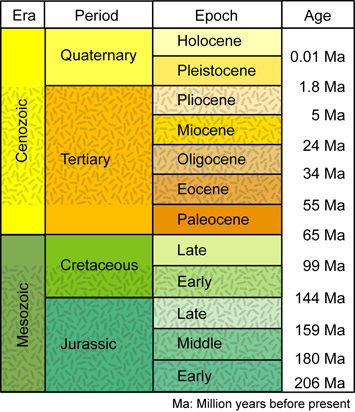[/caption]
When it comes to the geological timeline, there are several periods that scientists and biologists recognize as being of extreme importance to the development of life on Earth. There’s the Hadean period, which began with the creation of the Earth and was marked by the formations of the oceans and atmosphere. Or the Cambrian period, when the massive continent of Pangaea broke up and allowed for the explosion of life which led to the development of all modern Phyla. But when it comes to us mammals, perhaps the most important period was the one known as the Tertiary Period. This period began 65 million years ago and ended roughly 1.8 million years ago and bore witness to some major geological, biological and climatological events. This included the current configuration of the continents, the cooling of global temperatures, and the rise of mammals as the planet’s dominant vertebrates. It followed the Cretaceous period and was superseded by the Quaternary.
In terms of major events, the Tertiary period began with the demise of the non-avian dinosaurs in the Cretaceous–Tertiary extinction event, at the start of the Cenozoic era, and lasted to the beginning of the most recent Ice Age at the end of the Pliocene epoch. In terms of geology, there was a great deal of tectonic activity that continued from the previous era, culminating in the splitting of Gondwana and the collision of the Indian landmass with the Eurasian plate. This led to the formation of the Himalayas, the gradual creation of the continent of Australia (a haven for the non-placental, marsupial mammals), the separation South America from West Africa and its connection to North America, and Antarctica taking its current position below the South Pole. In terms of climate, the period was marked by widespread cooling, beginning in the Paleocene with tropical-to-moderate worldwide temperatures and ending before the first extensive glaciation at the start of the Quaternary.
In terms of species evolution, this period was of extreme importance to modern life. By the beginning of the period, mammals replaced reptiles as the dominant vertebrates on the planet. In addition, all non-avian dinosaurs (referring to terrestrial dinosaurs and not their avian descendants) had all become extinct by the beginning of this period. Modern types of birds, reptiles, amphibians, fish, and invertebrates were already numerous at the beginning of this period but also continued to appeared early on, and many modern families of flowering plants evolved. And last, but certainly not least (at least for us human folk), the earliest recognizable hominid relatives of humans appeared. One striking example of this is the Proconsul Primate, a tree-dwelling Primate that existed from roughly 23 to 17 million years ago and who’s fossilized remains have been found today in modern Kenya, Uganda and other East African locales.
We have written many articles about Tertiary Period for Universe Today. Here’s an article about the Quaternary Period, and here’s an article about the asteroid extinction theory.
If you’d like more info on the Tertiary Period, check out the USGS Geologic Time Scale, and here’s a link to another article about the Tertiary Period.
We’ve also recorded an episode of Astronomy Cast all about planet Earth. Listen here, Episode 51: Earth.
Sources:
http://en.wikipedia.org/wiki/Tertiary
http://en.wikipedia.org/wiki/Cretaceous%E2%80%93Tertiary_extinction_event
http://en.wikipedia.org/wiki/Gondwana#Cenozoic
http://en.wikipedia.org/wiki/Proconsul_%28genus%29
http://en.wikipedia.org/wiki/Dinosaur

